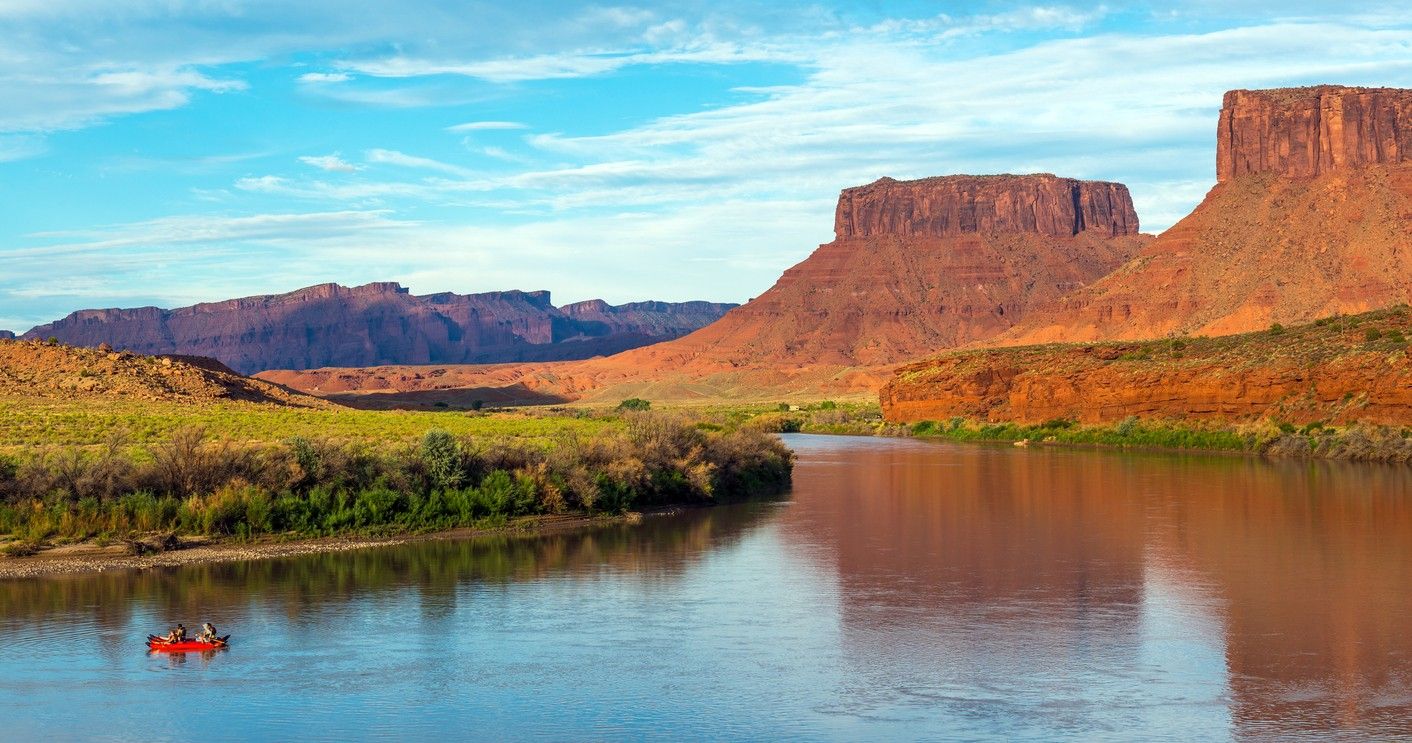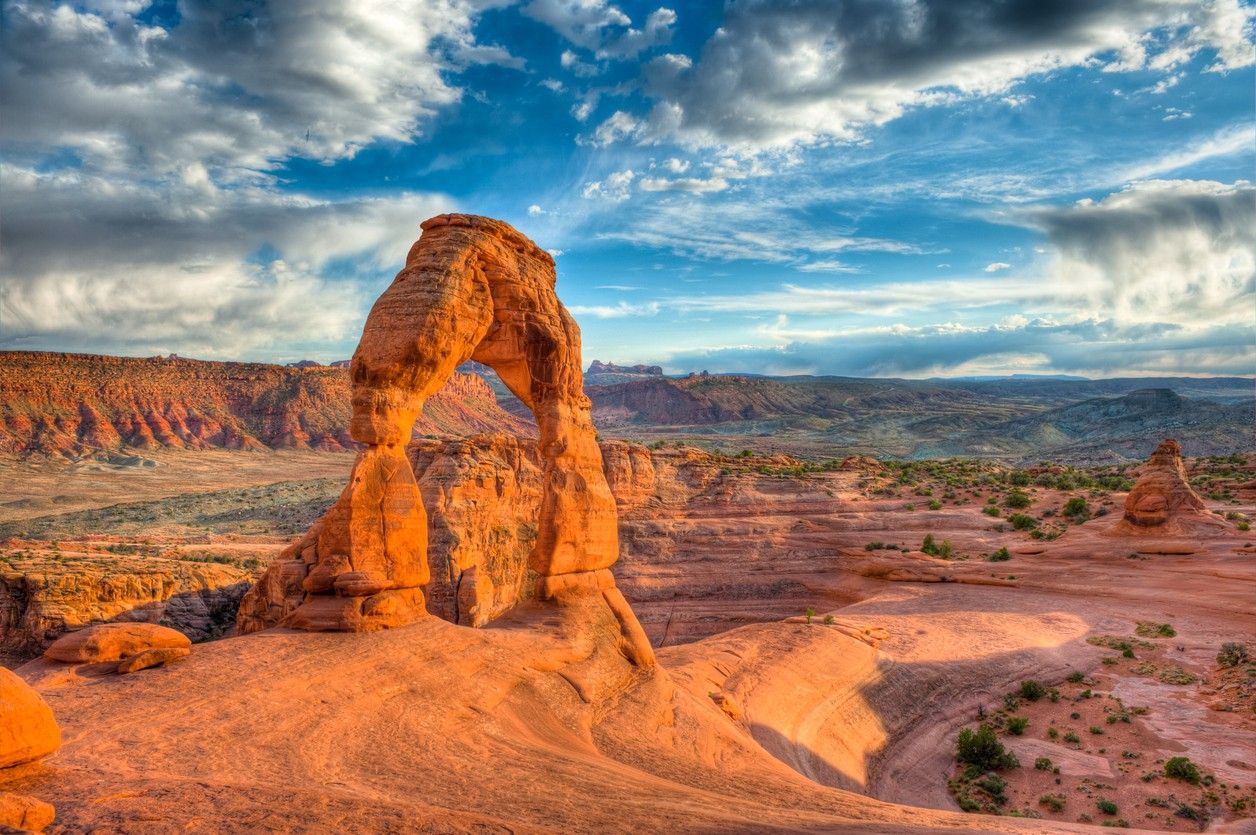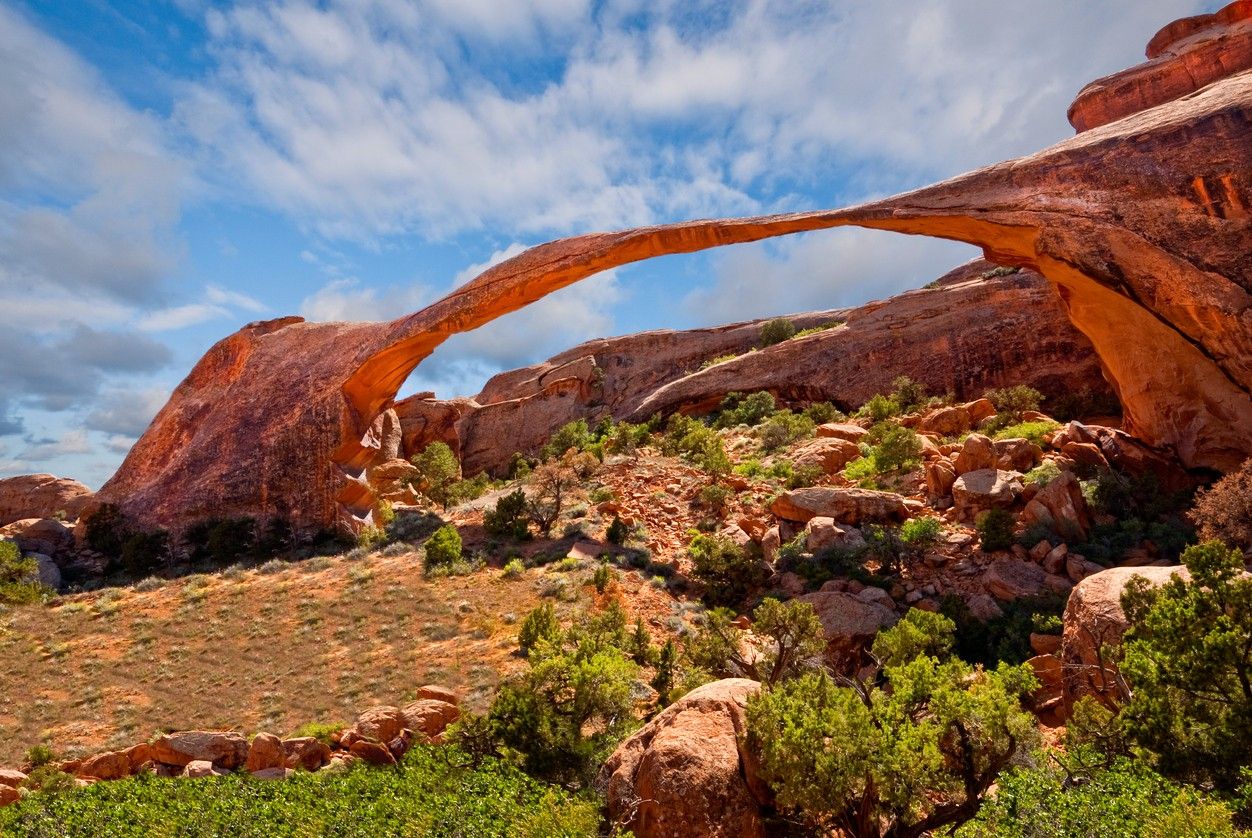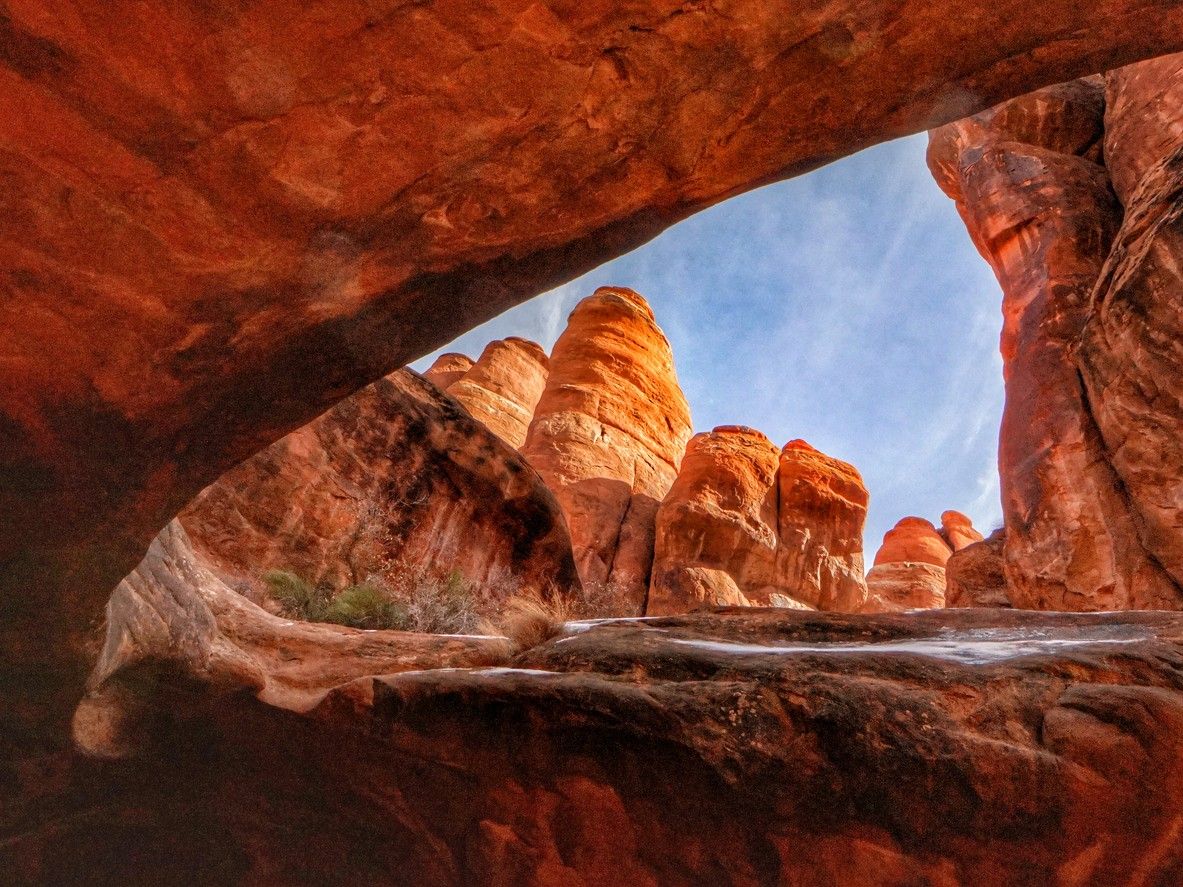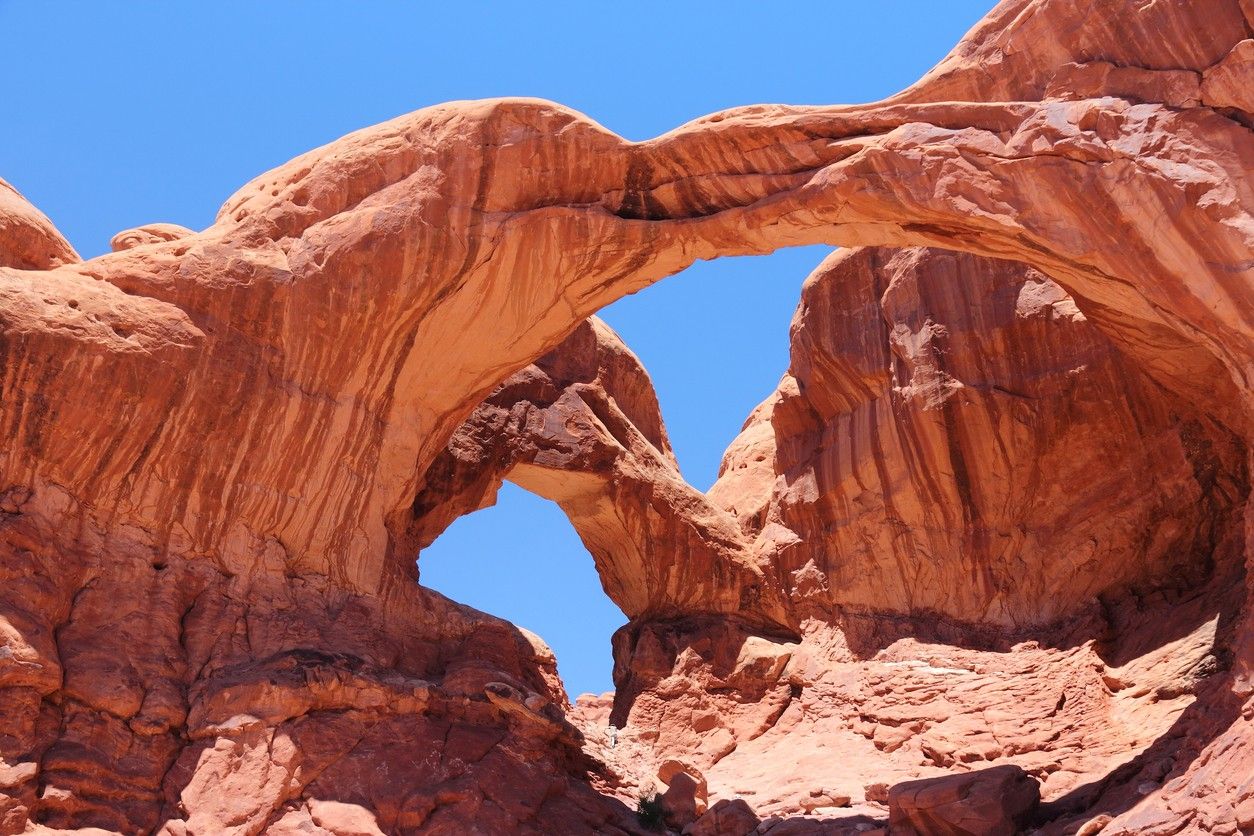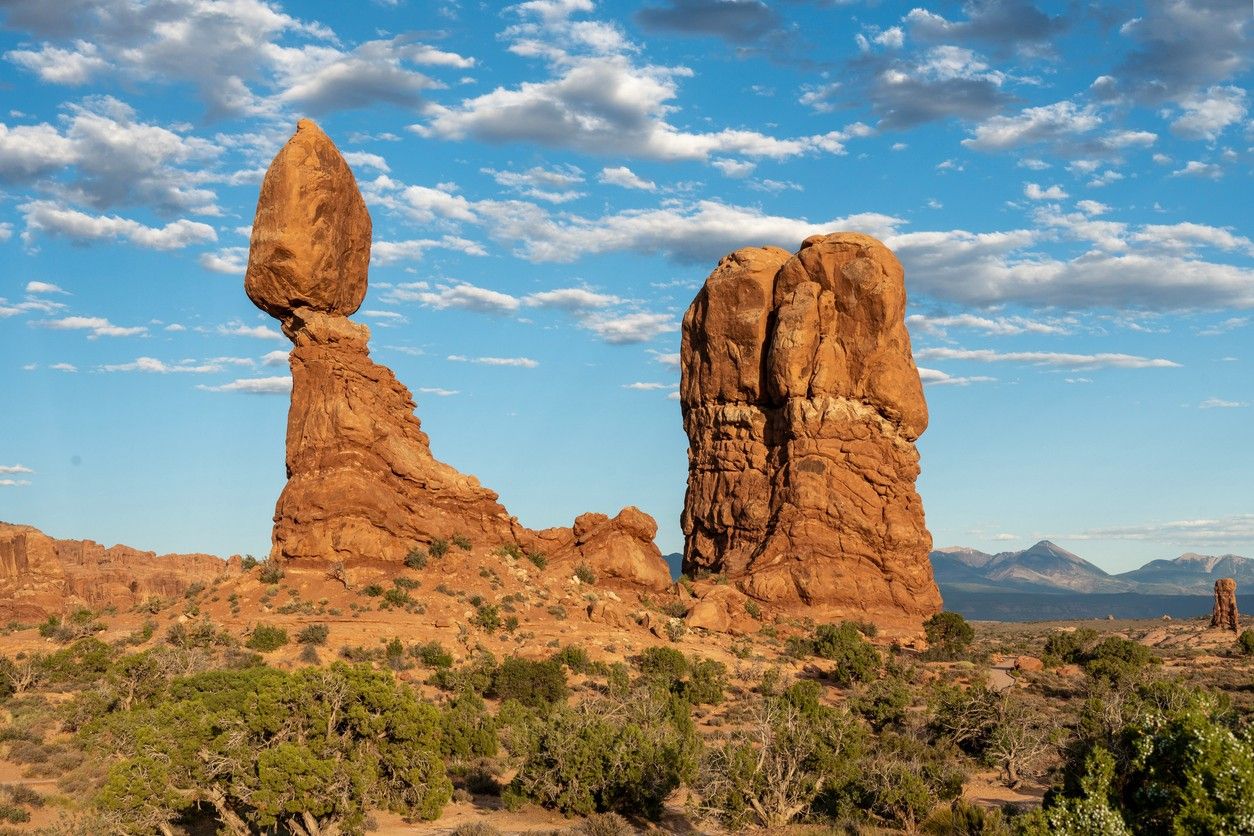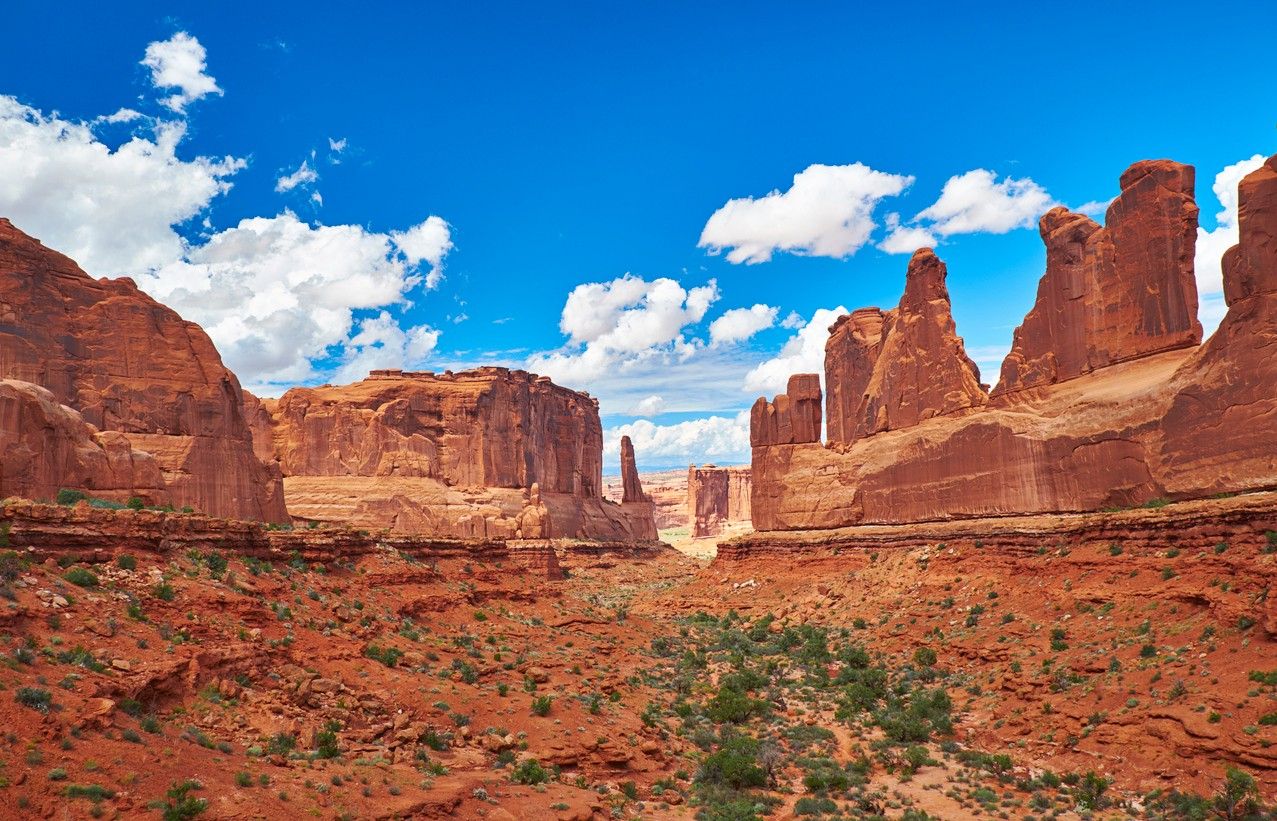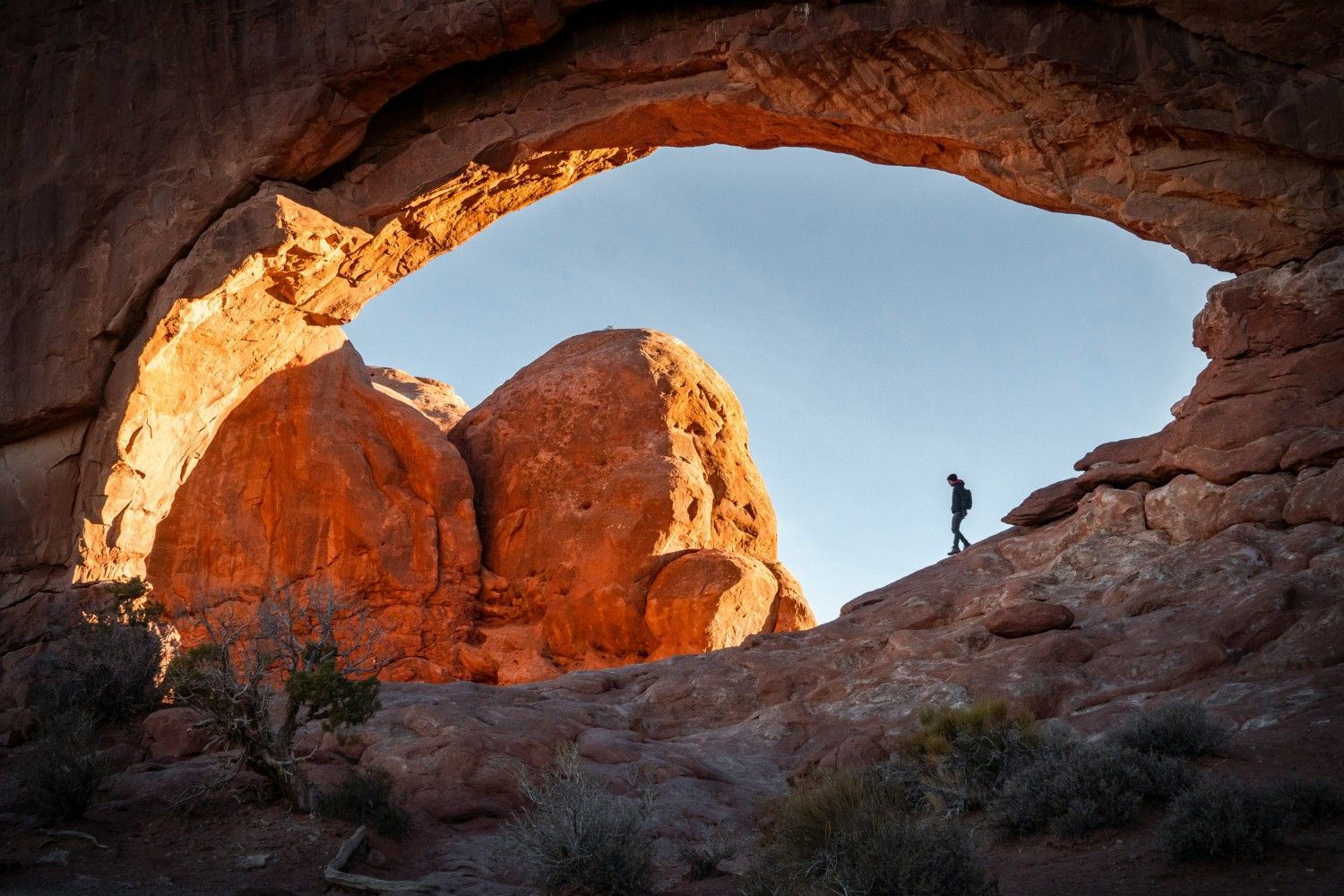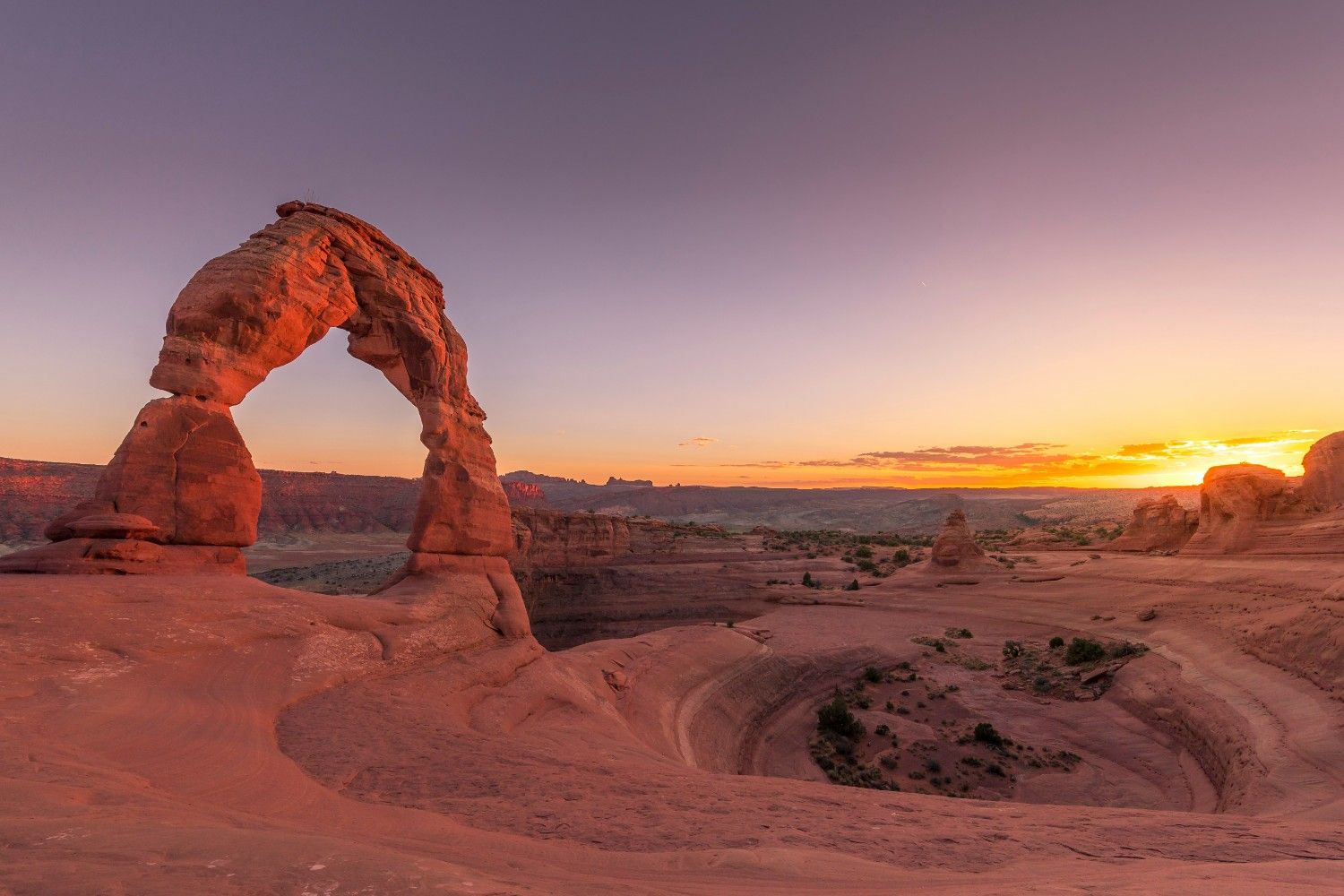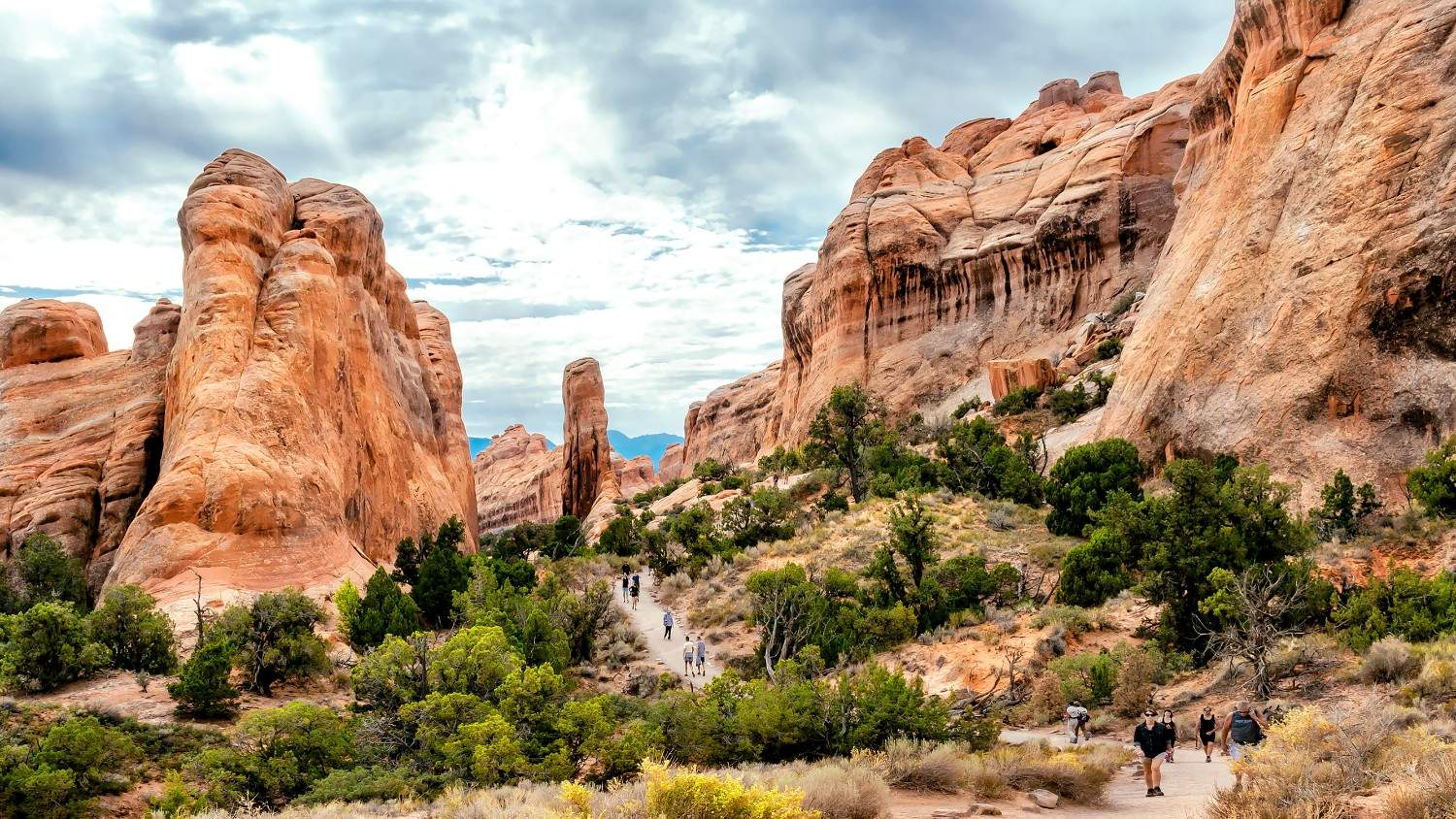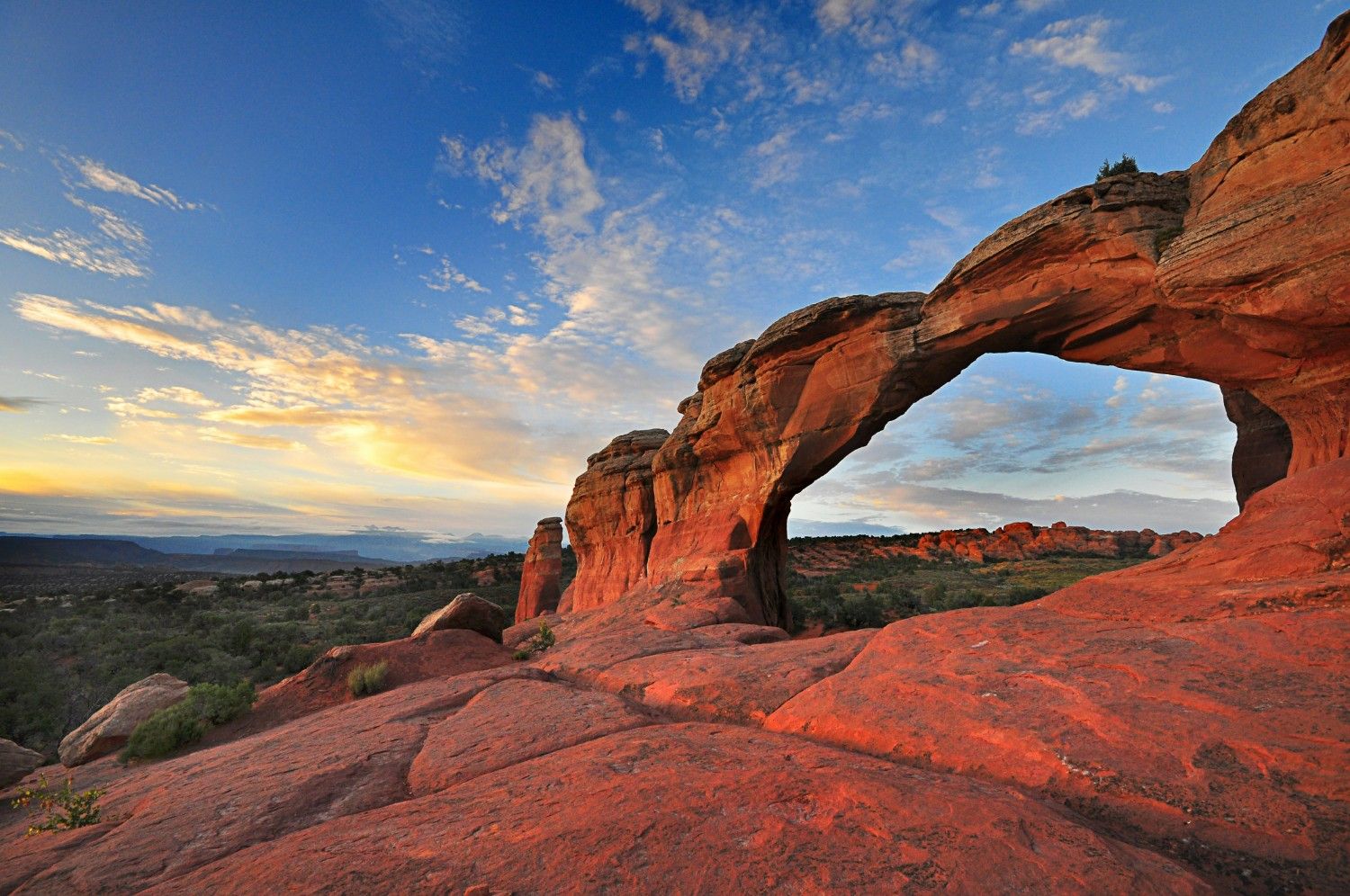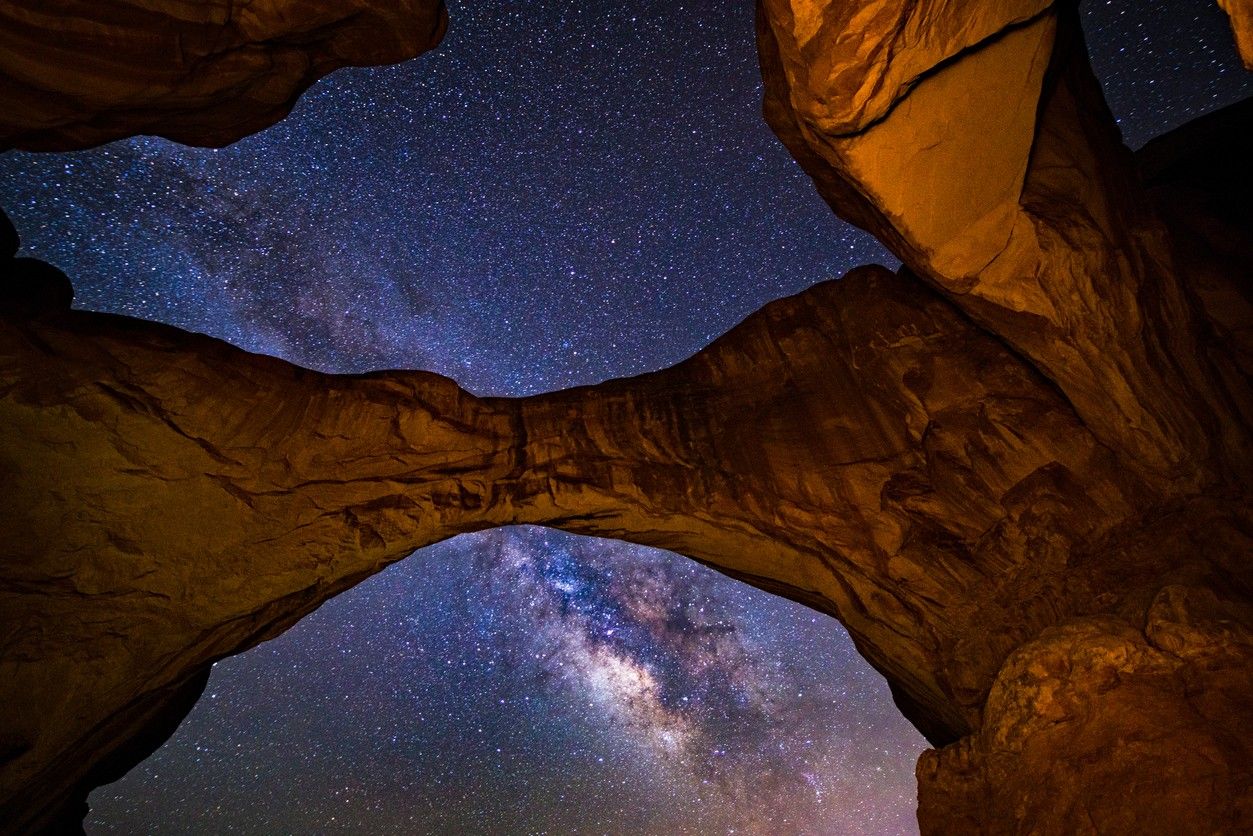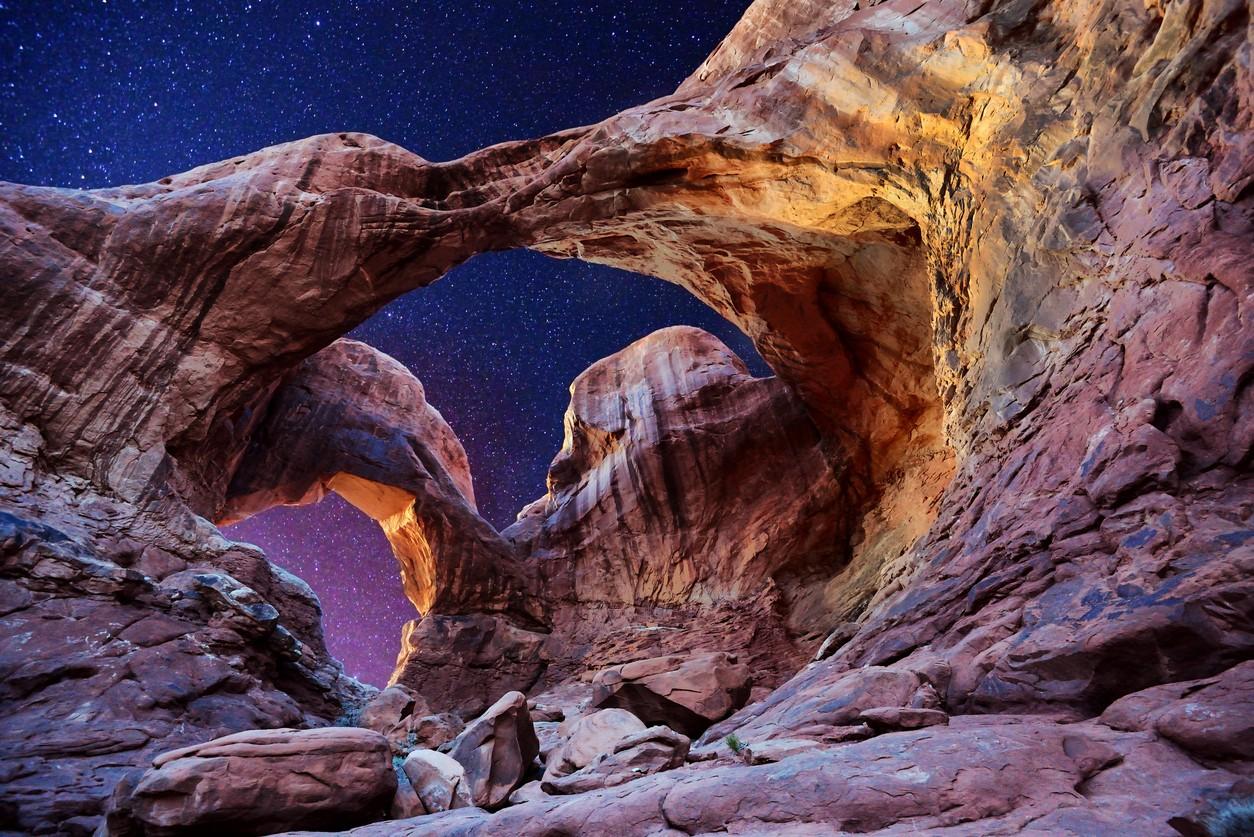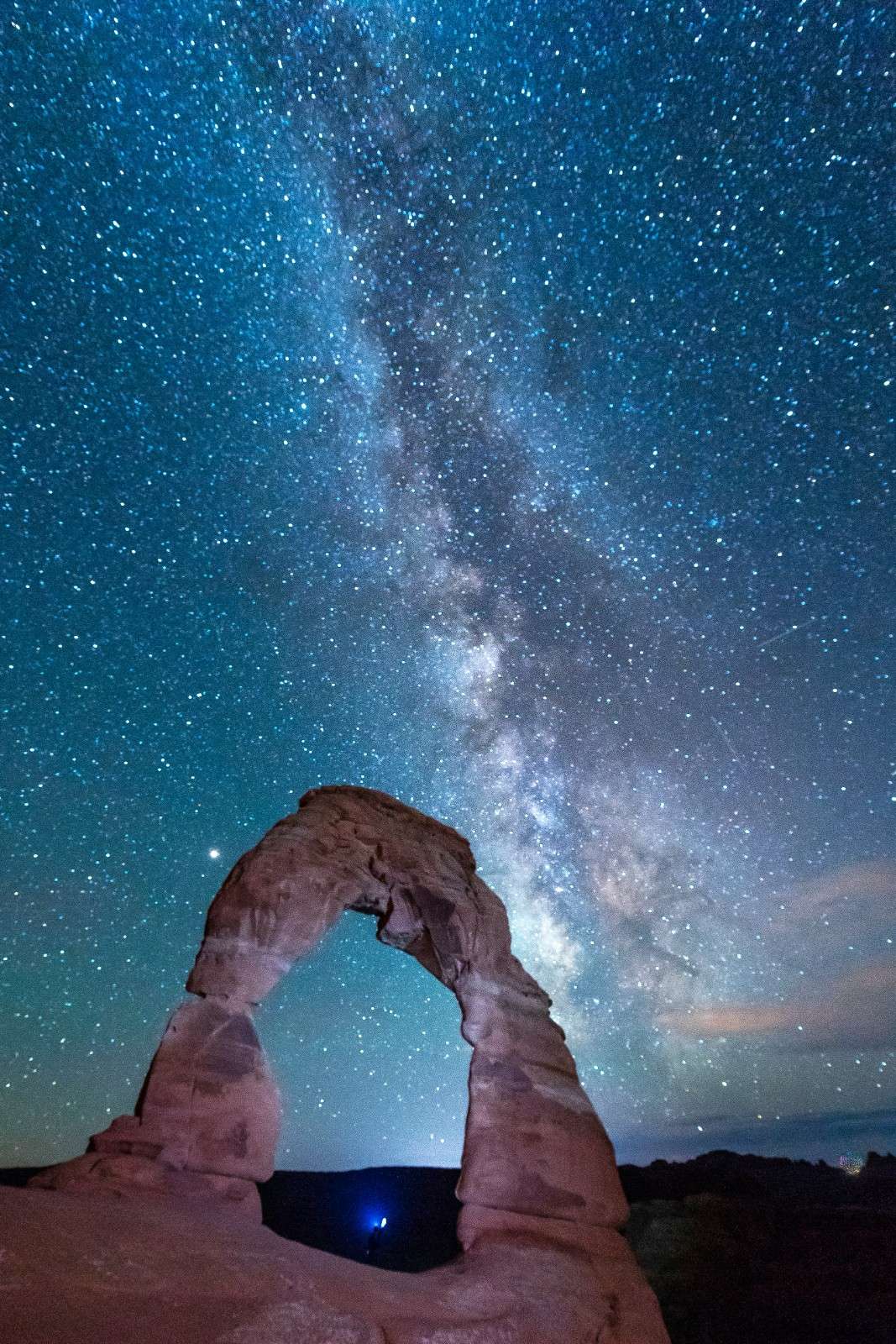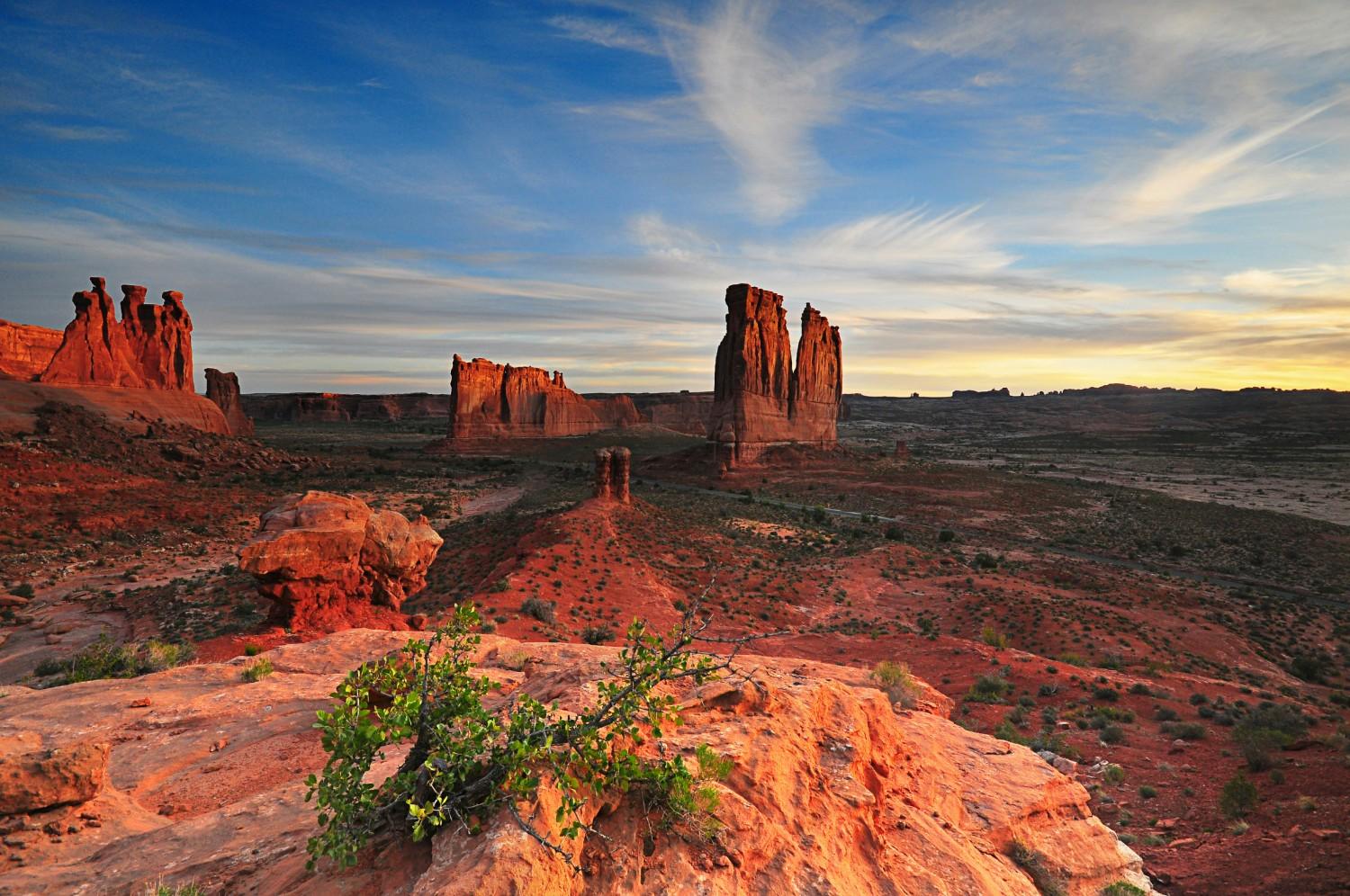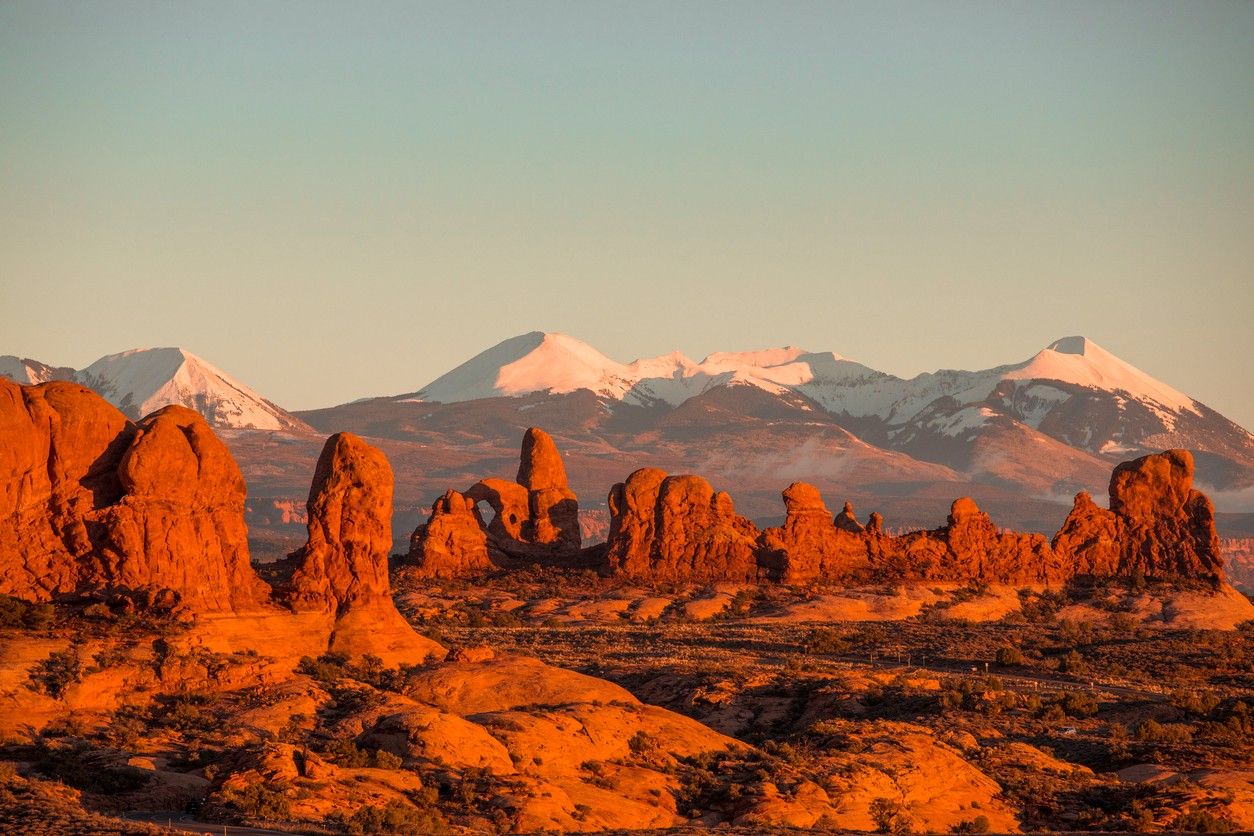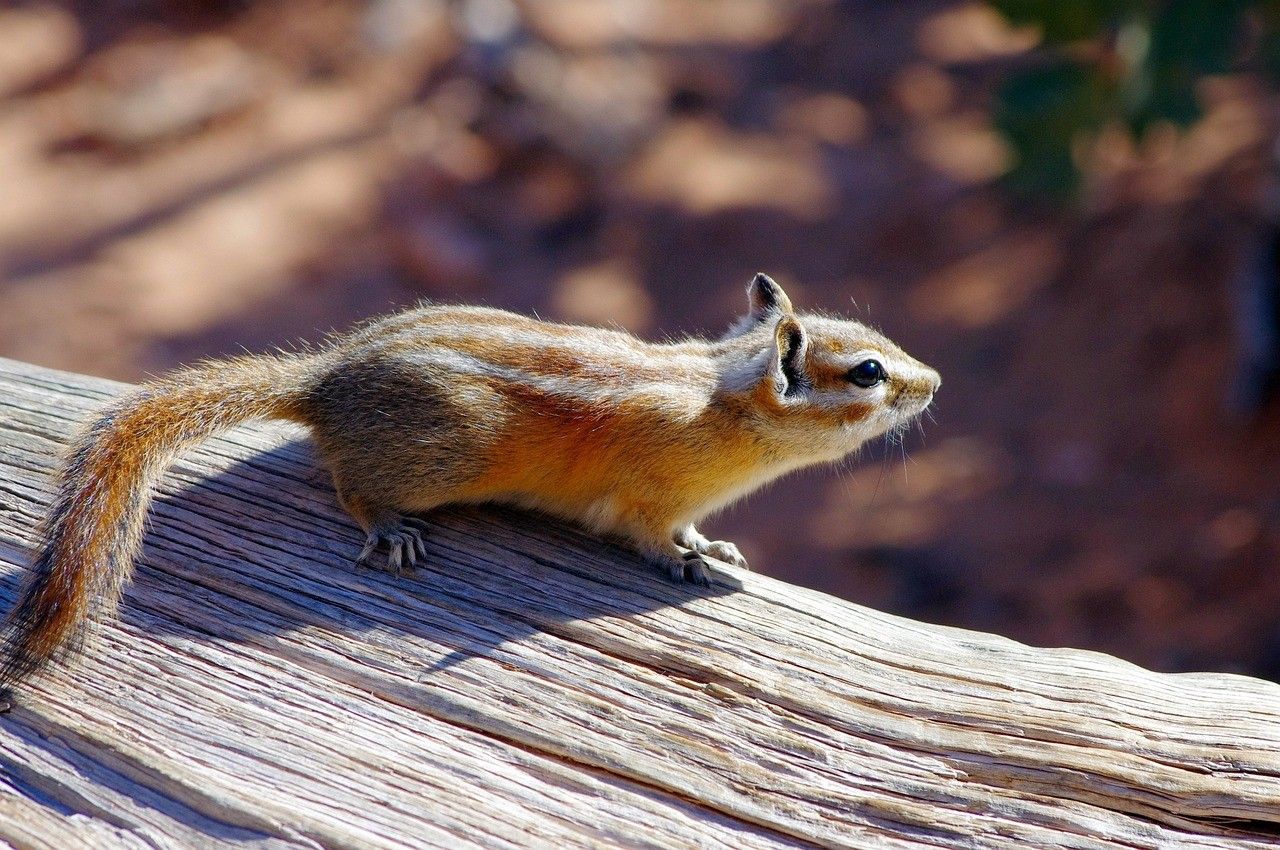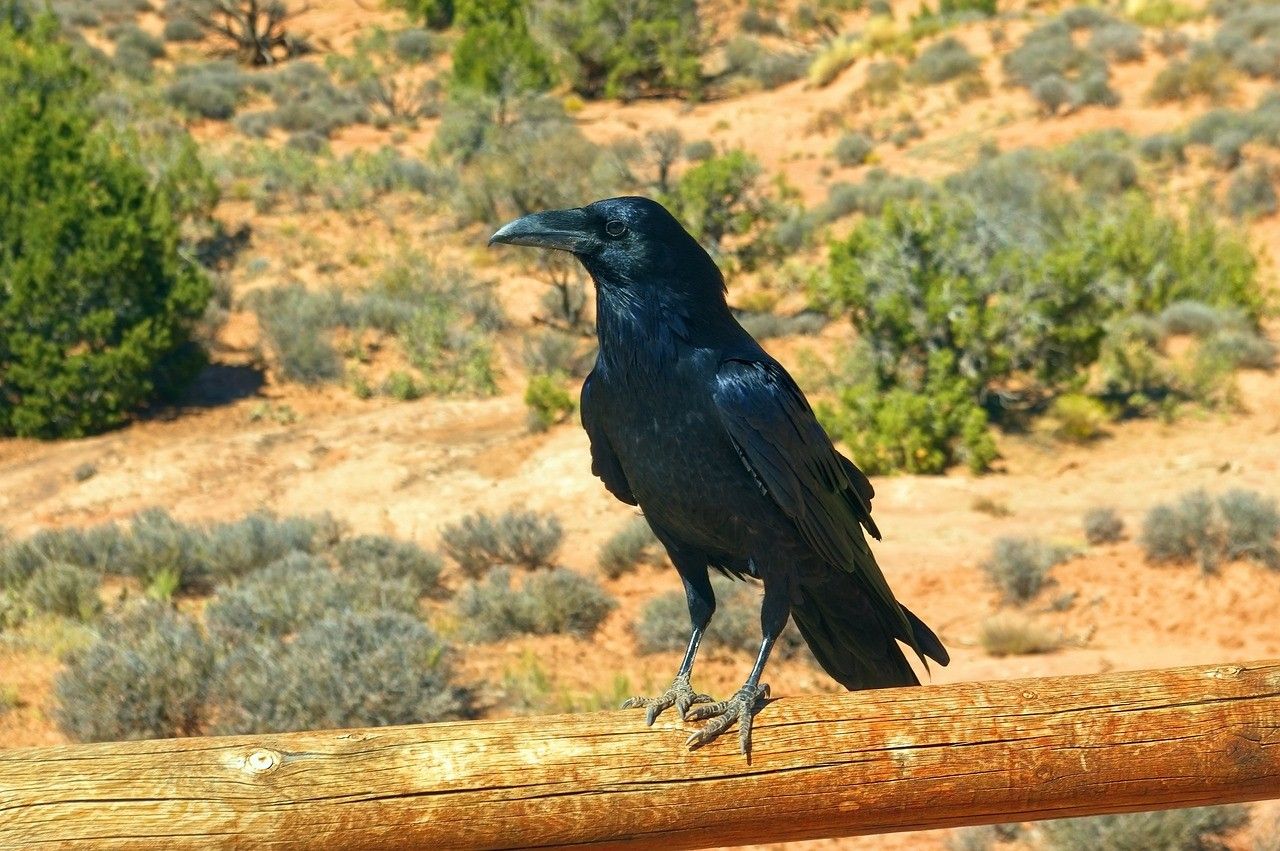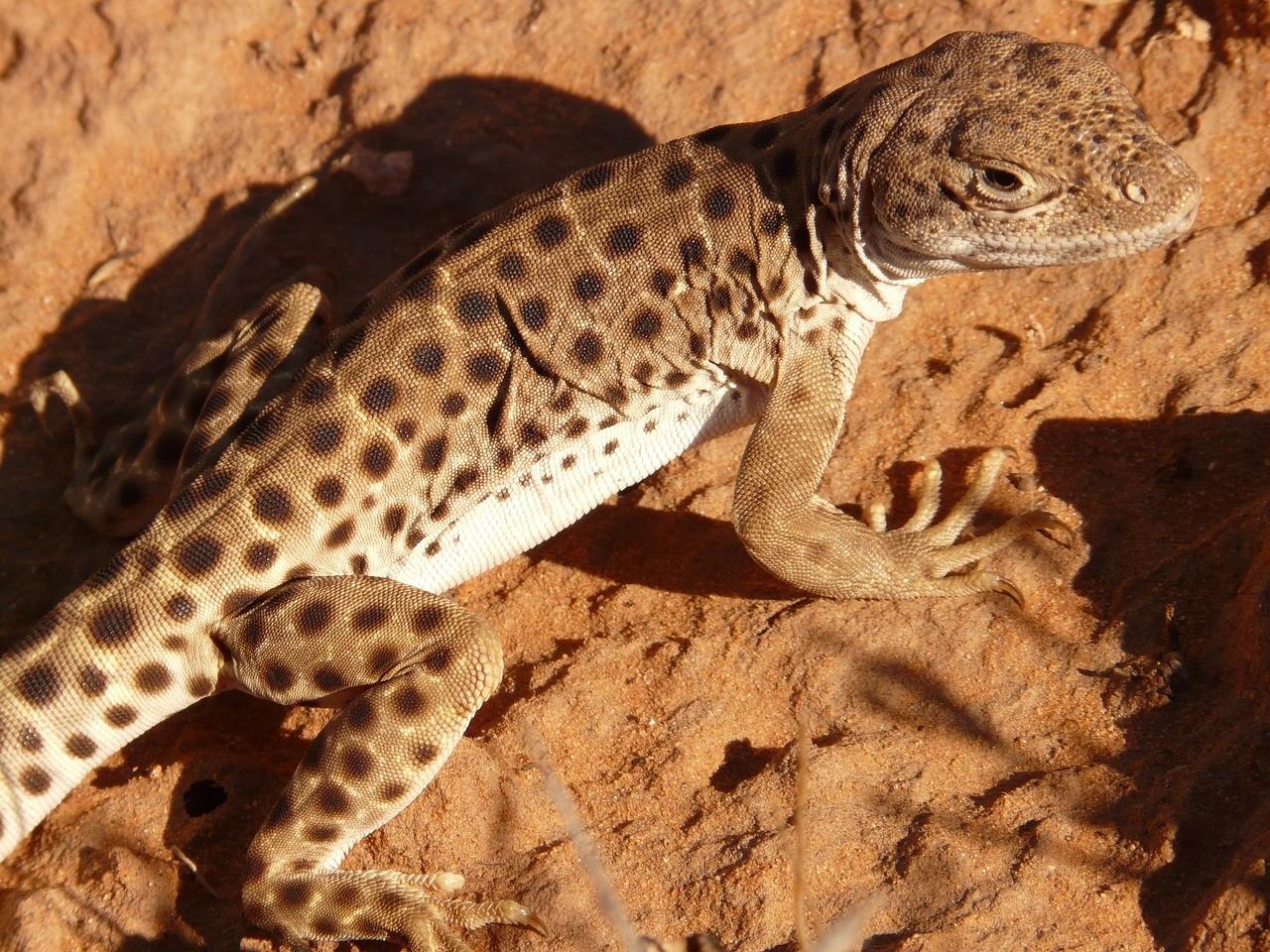Arches National Park, located in eastern Utah, is a magnificent testament to the sculpting power of nature. This iconic park is home to over 2,000 natural sandstone arches, as well as an array of other striking geological formations such as towering pinnacles, massive fins, and balanced rocks. The landscape here has been shaped over millions of years by the forces of erosion, resulting in a breathtaking desert wonderland that attracts visitors from all over the world. The park spans an area of 76,679 acres and is situated in the high desert region of the Colorado Plateau. Despite the harsh, arid conditions, Arches National Park supports a surprising diversity of plant and animal life that has adapted to thrive in this unique environment. From the hardy pinyon pines and juniper trees that dot the landscape to the elusive desert bighorn sheep that roam the park's rugged terrain, there is much to discover in this captivating wilderness.
What makes Arches National Park truly special is its unparalleled concentration of natural arches. These stunning formations range in size from tiny openings barely large enough to crawl through to massive spans like Landscape Arch, which measures an impressive 306 feet from base to base. Other notable arches include Delicate Arch, the park's most famous and photographed landmark, and Double Arch, where two arches share the same stone foundation. Today, Arches National Park welcomes over 1.5 million visitors each year who come to marvel at its otherworldly landscapes, hike its scenic trails, and experience the profound beauty and solitude of the desert. Whether you're a seasoned outdoor enthusiast or simply seeking a unique and unforgettable adventure, Arches National Park promises to leave you in awe of the raw power and majesty of the natural world.
Exploring the Park's Iconic Arches and Formations
Arches National Park is renowned for its stunning array of natural rock arches, towering spires, and unique geological formations sculpted by millions of years of erosion. Exploring these iconic landmarks is an absolute must for any visitor to the park.
Delicate Arch
Delicate Arch, the undisputed crown jewel of Arches National Park, is an awe-inspiring natural wonder that has captivated visitors from around the world. This freestanding arch, which adorns Utah's license plates and serves as the official symbol of the park, stands at an elevation of 4,829 feet (1,472 meters) in the Wolfe Ranch area. From base to crest, it reaches a maximum height of 52 feet (16 meters), its slender yet sturdy frame creating a breathtaking silhouette against the desert sky. The journey to witness Delicate Arch up close is a rewarding challenge in itself. Visitors must embark on a 3-mile (4.8 km) round-trip hike that gains 480 feet (146 meters) in elevation, navigating over slick rock sections and exposing themselves to the elements of the high desert. The trail is considered strenuous, but those who persevere are rewarded with an unparalleled view of this iconic arch that has graced countless postcards, photographs, and adventurers' dreams.
One remarkable fact about Delicate Arch is that it nearly met an untimely demise in the 1970s. A massive slab of rock, weighing countless tons, fell from one of the vertical walls adjacent to the arch, narrowly missing the delicate structure itself. This close call serves as a sobering reminder of the fragile and ever-changing nature of these geological wonders, sculpted by millions of years of erosion and yet vulnerable to the whims of time and the elements.
Landscape Arch
With a span of 306 feet (93 meters), Landscape Arch is a true marvel of nature and one of the longest natural rock spans in the world. This slender, delicate arch is nestled in the Devil's Garden area of Arches National Park, accessible via a moderate 1.6-mile (2.6 km) round-trip hike from the Devil's Garden Trailhead. Formed through the relentless process of erosion, Landscape Arch is a remarkable example of the power of wind, water, and time. As visitors approach this breathtaking formation, they are struck by its sheer size and the seemingly impossible span it has achieved, defying the laws of gravity and standing as a testament to the resilience of nature.
One fascinating fact about Landscape Arch is that it was once even longer than its current impressive span. In 1991, a massive slab fell from the arch, creating the opening we see today and reducing its length from over 600 feet (183 meters) to its current size. This dramatic event serves as a reminder of the ever-changing nature of these geological wonders and the forces that continually shape and reshape them. While Landscape Arch is a sight to behold, visitors are advised to admire this formation from a safe distance, as rock falls and collapses are not uncommon in the park. The fragility of these natural wonders is a constant reminder of the importance of preserving and protecting them for generations to come.
Fiery Furnace
Deep within the heart of Arches National Park lies the Fiery Furnace, a captivating labyrinth of narrow canyons, towering fins, and intricate sandstone formations that can only be explored with a permitted guide or on a ranger-led hike. This otherworldly maze offers visitors a unique opportunity to navigate through the very essence of the park's geological wonders, up close and personal. Towering sandstone fins cast long shadows across the narrow passages, creating a striking contrast of light and dark that shifts with the movement of the sun. Around every corner, visitors are greeted by formations with evocative names like "The Tombstones" and "The Corkscrew," each one more impressive and awe-inspiring than the last.
The roughly 2-mile (3.2 km) round-trip hike through this area is considered strenuous and technically challenging, requiring some scrambling and route-finding skills. Visitors must carefully navigate over obstacles, squeeze through narrow openings, and sometimes even climb up and down steep rock faces, all while marvelling at the intricate patterns and textures carved into the sandstone by millions of years of erosion. Fiery Furnace was once used as a natural corral by cowboys in the late 19th century. These hardy individuals would herd their cattle into the canyons, using the towering walls and narrow passages as a means of protection from harsh weather conditions and predators. Today, visitors can imagine the echoes of these bygone cowboys as they explore the same labyrinth that once sheltered them and their livestock.
Double Arch
In the heart of the Windows Section of Arches National Park stands Double Arch, a remarkable geological formation that consists of two massive arches fused, creating a striking silhouette against the desert sky. This iconic landmark is easily accessible via a short, flat 0.5-mile (0.8 km) round-trip hike from the Double Arch Trailhead, making it a popular destination for visitors of all ages and abilities. With a span of 144 feet (44 meters) and a height of 112 feet (34 meters), Double Arch is an impressive sight to behold. As visitors approach, the sheer scale of this formation becomes apparent, dwarfing even the tallest of onlookers. The two arches, carved from the same massive fin of sandstone, are fused in a seemingly precarious yet resilient embrace, a testament to the enduring power of nature.
Visitors can walk beneath the arches and explore the area around them, capturing stunning photographs and marvelling at the intricate patterns and textures carved into the sandstone by millions of years of erosion. The play of light and shadow across the arches' spans creates a constantly shifting display of colours and contrasts, making each visit a unique and awe-inspiring experience. One fascinating fact about Double Arch is that it was once part of a larger, continuous fin of sandstone that has gradually eroded over time, leaving behind these two iconic arches. This process of erosion continues even today, with wind and water slowly but steadily reshaping the landscape, ensuring that the beauty of Double Arch will continue to evolve for generations to come.
Balanced Rock
Along the Park Avenue trail, visitors are greeted by a remarkable sight – Balanced Rock, a towering formation that seems to defy the laws of gravity. This iconic landmark stands at 128 feet (39 meters) tall and features a massive sandstone boulder weighing an estimated 3,577 tons, precariously balanced atop a slender pedestal. As visitors approach Balanced Rock, they can't help but be awestruck by the sheer size and seemingly impossible balance of this formation. The massive boulder, sculpted by millions of years of erosion, appears to teeter on the edge of its pedestal, challenging the boundaries of stability and equilibrium.
To reach Balanced Rock, visitors can take the easy 0.3-mile (0.5 km) round-trip trail from the Balanced Rock Trailhead, or incorporate it into a longer hike along the Park Avenue trail. Whichever route they choose, the sight of this natural wonder is sure to leave a lasting impression. Despite its appearance, it is not balanced at all. The massive boulder is firmly anchored to the pedestal it rests upon, a result of the intricate patterns of erosion that have shaped this formation over aeons. However, from a distance, it certainly appears to be delicately balanced, a testament to the illusions and tricks of perspective that nature so often plays on the human eye.
Park Avenue
Imagine strolling through the heart of a towering urban skyline, with skyscrapers of sandstone reaching toward the heavens and narrow canyons casting long shadows across your path. This is the surreal experience that awaits visitors to Park Avenue, a stunning collection of towering sandstone walls and fins that resemble an urban landscape like no other. Located along the Park Avenue trail, which spans 2 miles (3.2 km) one way, this unique area offers visitors a chance to immerse themselves in the very essence of Arches National Park's geological wonders. As they hike through the narrow passages, surrounded by massive sandstone walls that rise to 600 feet (183 meters) tall, visitors can't help but feel a sense of awe and wonder at the forces that have shaped this incredible landscape.
The trail itself is relatively easy, with minimal elevation gain, making it accessible for most visitors. However, the experience of being enveloped by these towering formations is anything but ordinary. The play of light and shadow across the intricate patterns and textures of the sandstone creates a constantly shifting display of colours and contrasts, evoking a sense of otherworldly beauty. Park Avenue was once the site of a massive dune field, with the towering fins and walls we see today forming from the erosion of these ancient dunes over millions of years. As visitors gaze upon these imposing formations, they can imagine the vast expanse of sand that once covered this landscape, slowly sculpted by the patient hands of wind and water into the remarkable structures we now admire.
Outdoor Activities
IArches National Park offers a wealth of opportunities for outdoor enthusiasts to explore and experience the natural beauty of this incredible landscape. From hiking and rock climbing to stargazing and photography, there is something for everyone to enjoy.
Hiking
With over 18 marked trails ranging from easy nature walks to strenuous backcountry treks, hiking is one of the most popular activities in Arches National Park. Whether you're seeking a stroll or a challenging multi-day adventure, the park offers a diverse array of hiking options to suit all skill levels.
Delicate Arch Trail — This strenuous 3-mile (4.8 km) round-trip hike leads to the iconic Delicate Arch, one of the most famous landmarks in the park, located in the Wolfe Ranch area.
Landscape Arch Trail — A moderate 1.6-mile (2.6 km) round-trip hike in the Devil's Garden area that takes you to the massive Landscape Arch, one of the longest natural rock spans in the world.
Double O Arch Trail — This easy 4.2-mile (6.8 km) loop trail in the Windows Section offers stunning views of Double O Arch and other sandstone formations.
Park Avenue Trail — An easy 2-mile (3.2 km) one-way trail that winds through a stunning collection of towering sandstone walls and fins resembling an urban skyline.
Devil's Garden Loop — A strenuous 7.9-mile (12.7 km) loop trail in the Devil's Garden area that provides access to several iconic arches, including Landscape Arch and Double O Arch.
Fiery Furnace (Guided Tour Only) — This strenuous 2-mile (3.2 km) round-trip hike can only be done with a permitted guide, taking you through a labyrinth of narrow canyons and sandstone formations.
Broken Arch Loop — A moderate 1.8-mile (2.9 km) loop trail that leads to the impressive Broken Arch, located near the Cove of Caves area.
Windows Loop — An easy 1-mile (1.6 km) loop trail in the Windows Section that offers up-close views of iconic arches like Double Arch and the North and South Windows.
Whether you opt for a short, family-friendly stroll or a full-day adventure, the hiking trails of Arches National Park offer unparalleled opportunities to explore and experience the park's stunning landscapes and geological wonders.
Rock Climbing
Arches National Park is a mecca for rock climbers, with its unique sandstone formations offering a wide range of challenging routes and breathtaking vistas. While climbing on any arch or prohibited area within the park is strictly forbidden to preserve these delicate natural wonders, several designated areas offer world-class climbing opportunities.
Tower of Babel — This popular climbing area features a variety of routes suitable for beginners to experienced climbers, located near the Windows Section.
Courthouse Towers — A series of towering sandstone spires offering advanced multi-pitch climbing routes, situated in the Courthouse Wash area.
The Spectacles — A pair of impressive sandstone towers with several moderate to difficult climbing routes, found in the Windows Section just off the Windows Loop Trail.
Wall Street — A long, massive wall with numerous cracks and face climbing routes of varying difficulties, located in the Salt Valley area.
Klondike Bluffs — This area features a range of single and multi-pitch routes, including some of the tallest climbs in the park, situated near the Devil's Garden Campground.
The Lyre — A towering sandstone formation with challenging crack and face climbing routes, found in the Cove of Caves area.
It's important to note that climbing permits and adherence to regulations are required in Arches National Park. Climbing is only allowed in designated areas, and climbers must use proper techniques and equipment to minimise their impact on the fragile sandstone formations. Additionally, certain areas may be closed during specific seasons to protect nesting raptors. For those seeking an adrenaline-fueled adventure amidst the park's stunning geological wonders, rock climbing in Arches National Park offers an unforgettable experience. However, responsible and ethical climbing practices are essential to ensure the preservation of these natural treasures for generations to come.
Photography
With its iconic landscapes, dramatic light, and ever-changing colours, Arches National Park is a photographer's paradise. From capturing the perfect shot of Delicate Arch at sunset to exploring the intricate patterns and textures of the park's sandstone formations, there are endless opportunities for stunning photography. One of the most sought-after subjects for photographers is the park's namesake arches. The play of light and shadow on these natural wonders creates constantly shifting displays of colour and contrast, making each visit a unique and awe-inspiring experience. Some of the most popular arches for photography include Delicate Arch, Landscape Arch, Double Arch, and the North and South Windows.
Aside from the arches, Arches National Park offers a wealth of other photographic opportunities. The towering sandstone fins and walls of Park Avenue provide a surreal backdrop that resembles an urban skyline, while the twisted and sculpted formations of the Fiery Furnace offer a labyrinth of abstract shapes and patterns to capture. For landscape photographers, the vast open spaces and sweeping vistas of the park provide ample opportunities to capture stunning panoramic shots. The La Sal Mountains in the distance create a dramatic backdrop, while the ever-changing light and weather conditions can create breathtaking scenes of clouds, shadows, and vibrant colours.
One of the best times for photography in Arches National Park is during the golden hours around sunrise and sunset. The low-angle light casts warm hues across the sandstone formations, creating a sense of depth and texture that is simply unmatched. Photographers often flock to popular locations like Delicate Arch Viewpoint, Turret Arch, and Balanced Rock to capture these magical moments. In addition to the stunning landscapes, Arches National Park also offers opportunities for wildlife photography. The park is home to a diverse array of desert creatures, including bighorn sheep, mule deer, and a variety of birds of prey, such as hawks and golden eagles. For photographers of all skill levels, Arches National Park offers a wealth of opportunities to capture the beauty and grandeur of this unique and awe-inspiring landscape. With patience, creativity, and an appreciation for the natural wonders around every corner, photographers can create images that truly capture the essence of this remarkable destination.
Stargazing
Thanks to its remote location and lack of light pollution, Arches National Park is an ideal destination for stargazing. On clear nights, visitors can marvel at the Milky Way and countless stars, planets, and celestial bodies in the vast, dark skies above. One of the best places for stargazing in the park is the Panorama Point area, which offers unobstructed views of the night sky. Here, visitors can witness the full majesty of the Milky Way stretching across the heavens, a sight that is often obscured by light pollution in urban areas.
Another popular stargazing spot is the Devils Garden Campground, where campers can spend the night under the stars and take in the celestial wonders above. The park's remote location and minimal artificial light create ideal conditions for observing the night sky in all its glory. During certain times of the year, Arches National Park offers ranger-led stargazing programs, where knowledgeable park rangers provide guidance and information about the constellations, planets, and other celestial bodies visible in the night sky. These programs often include the use of telescopes and other astronomical equipment, allowing visitors to get an up-close look at the wonders of the universe.
The park's dark skies allow for clear and unobstructed views of celestial phenomena that are often obscured elsewhere. Visitors can witness meteor showers, eclipses, and even the occasional celestial alignment, all while surrounded by the park's stunning geological formations. In addition to the breathtaking night sky, Arches National Park also offers opportunities for astrophotography. The park's remote location, coupled with its lack of light pollution, provides the perfect backdrop for capturing stunning images of the Milky Way, star trails, and other celestial events.
Ranger Programs
Throughout the year, Arches National Park offers a variety of ranger-led programs, including guided hikes, evening talks, and educational activities. These programs provide visitors with an opportunity to learn about the park's geology, flora, fauna, and cultural history from knowledgeable park rangers. One of the most popular ranger programs in Arches National Park is the guided hike to Delicate Arch. Led by experienced park rangers, these hikes offer a unique opportunity to learn about the formation and significance of this iconic arch while enjoying a challenging yet rewarding trek through the park's stunning landscapes.
For those interested in exploring the park's lesser-known areas, the park offers guided hikes into the Fiery Furnace. This labyrinth of narrow canyons and towering sandstone fins can only be accessed with a permitted guide, making these ranger-led tours a truly unique and unforgettable experience. Arches National Park also offers evening programs and talks at the park's amphitheatre or visitor centre. These programs cover a wide range of topics, from the park's geology and natural history to its cultural significance and conservation efforts. Visitors can learn about the unique desert ecosystem, the ancient cultures that once called this region home, and the ongoing efforts to protect and preserve this remarkable landscape for future generations.
For families and children, the park offers a variety of educational programs and activities designed to engage and inspire young minds. These programs often involve hands-on activities, interactive exhibits, and engaging discussions that help foster a deeper appreciation and understanding of the natural world. One of the unique aspects of Arches National Park's ranger programs is the opportunity to learn about the park's dark sky initiatives. Through stargazing programs and astronomy talks, visitors can gain a deeper understanding of the importance of preserving dark skies and minimising light pollution, while also learning about the celestial wonders visible in the park's night sky.
Camping
Arches National Park offers camping opportunities within the park boundaries, allowing visitors to fully embrace the serenity and beauty of this natural wonder. Spending a night or two under the star-filled skies of Arches is an experience that will leave you with lasting memories and a deeper appreciation for the park's grandeur.
Devils Garden Campground — This is the only developed campground within Arches National Park, offering 51 campsites suitable for tents, RVs, and trailers. Located in the heart of the park, Devils Garden Campground provides easy access to some of the most iconic trails and formations, including the Landscape Arch Trail and the Devils Garden Loop. Amenities include potable water, flush toilets, and a dump station for RVs. Reservations are highly recommended, especially during peak seasons, as sites fill up quickly.
Arches National Park also offers backcountry camping opportunities for those seeking a more remote and primitive experience. Backcountry camping permits are required, and campers must adhere to strict regulations to minimise their impact on the fragile desert environment. Here are five popular backcountry camping areas:
Salt Valley — This expansive valley offers stunning views of the La Sal Mountains and provides access to the Klondike Bluffs climbing area. Campsites are scattered throughout the valley, offering seclusion and solitude.
Arches Plateau — Located near the park's eastern boundary, the Arches Plateau provides access to several remote hiking trails and affords panoramic views of the surrounding desert landscape.
Courthouse Wash — This area, situated near the park's western boundary, offers campsites nestled among towering sandstone formations, including the iconic Courthouse Towers.
Squaw Flat — Located in the heart of the Salt Valley, this area provides access to several archaeological sites and offers stunning views of the surrounding rock formations.
Lost Spring Canyon — This remote canyon offers a true backcountry experience, with campsites scattered along the canyon floor and opportunities for exploring nearby rock art and ancient ruins.
Camping in Arches National Park also offers a unique opportunity to connect with the park's diverse wildlife. As the day fades into night, the desert comes alive with the sounds of coyotes howling, owls hooting, and the rustling of small mammals foraging for food. In the morning, you may be greeted by the sight of bighorn sheep or mule deer grazing nearby, or witness the majestic silhouette of a soaring hawk against the backdrop of the rising sun.
Discovering the Park's Unique Flora and Fauna
Arches National Park is not just a geological wonder but also a vibrant ecosystem teeming with a diverse array of plant and animal life adapted to the harsh desert environment.
Desert Flora
Despite the arid conditions, Arches National Park is home to a surprising variety of plant life, each species uniquely adapted to thrive in this challenging environment.
Utah Juniper and Pinyon Pine — These hardy evergreens dot the landscape, providing shade and sustenance for many desert dwellers.
Yucca — With their tall, sword-like leaves and dramatic flower stalks, yuccas are a striking presence in the park.
Cryptobiotic Soil Crusts — These unique living crusts, composed of algae, fungi, and bacteria, play a crucial role in stabilising the desert soil and providing nutrients for other plants.
Desert Fauna
The park's diverse habitats, from towering sandstone formations to winding canyons, support an array of animal life that has adapted to the harsh desert conditions.
Desert Bighorn Sheep — These iconic inhabitants of the park can often be spotted navigating the rocky terrain with remarkable agility.
Mule Deer — Graceful and elusive, mule deer frequent the park's canyons and valleys in search of sustenance.
Reptiles — Lizards, snakes, and other reptiles thrive in the park's warm, arid climate, often seen basking in the sun or seeking shelter among the rocks.
Birds of Prey — With their keen eyesight and impressive wingspans, hawks, eagles, and falcons soar above the park, keeping a watchful eye on the landscape below.
Small Mammals — From the ubiquitous rock squirrels to the elusive kit foxes, the park is home to a diverse array of small mammals adapted to the desert environment.
Night Dwellers
As the sun sets and the park takes on a whole new character, a different cast of residents emerges to explore the cooler evening hours.
Bats — Several species of bats, including the Mexican free-tailed bat, can be seen flitting through the twilight skies, hunting for insects.
Nocturnal Predators — Coyotes, foxes, and bobcats become more active at night, stalking their prey and filling the air with their haunting calls.
Respecting and Preserving the Ecosystem
Arches National Park is a true gem, a delicately balanced ecosystem that has withstood the test of time. However, this fragile desert landscape is also vulnerable to the impacts of human activity. As visitors, it is our responsibility to tread lightly and take active steps to preserve and protect this natural wonder for generations to come. One of the most important ways to respect the park's ecosystem is to stay on designated trails at all times. Venturing off-trail can cause irreparable damage to the cryptobiotic soil crusts that play a crucial role in stabilising the desert soil and providing nutrients for other plants. These living crusts are incredibly fragile and can take decades, or even centuries, to recover from the impact of footprints or tyre tracks.
In addition to staying on trails, visitors should also refrain from disturbing or feeding any wildlife they encounter. While it may be tempting to approach or interact with the park's residents, such actions can disrupt their natural behaviours and put both humans and animals at risk. Instead, observe and appreciate these creatures from a respectful distance, using binoculars or telephoto lenses to capture their beauty without causing disturbance. Another critical aspect of preserving the park's ecosystem is maintaining cleanliness and minimising waste. Visitors should practice the principles of "Leave No Trace," packing out all trash and properly disposing of any waste. Even seemingly biodegradable items like fruit peels or nut shells can take years to decompose in the arid desert environment, disrupting the natural balance and potentially harming wildlife.
Additionally, visitors should be mindful of their impact on the park's water sources, which are vital lifelines for many plant and animal species. Avoid polluting or damaging these precious resources, and follow all regulations regarding water usage and conservation. Finally, it is essential to respect and protect the park's cultural and archaeological resources, which are an integral part of its ecosystem and history. These sites, which may include rock art, ancient dwellings, or artefacts, are fragile reminders of the indigenous cultures that once called this landscape home. Visitors should never disturb, remove, or deface these precious resources, as they are irreplaceable links to the past and hold deep spiritual and cultural significance.
By embracing a mindset of respect, responsibility, and stewardship, visitors to Arches National Park can play a vital role in preserving this remarkable ecosystem for future generations. Through small acts of conservation and conscious choices, we can ensure that the park's unique flora, fauna, and geological wonders continue to inspire and captivate those who seek to experience the majesty of the natural world.
Planning Your Visit to Arches National Park
Arches National Park is a breathtaking destination that offers visitors an unforgettable opportunity to explore and experience the natural wonders of the American Southwest. To ensure a safe and enjoyable visit, it's essential to plan and prepare for the unique challenges of this desert environment.
Best Times to Visit — The park is open year-round, but the most popular and comfortable times to visit are during the spring (April-May) and fall (September-October) months. These seasons offer mild temperatures, typically ranging from the 60s to 80s Fahrenheit (15-30°C), and fewer crowds than the summer months.
Entry Fees and Passes — Visitors are required to pay an entrance fee to enter Arches National Park. This fee helps support the park's maintenance, preservation, and educational programs. Consider purchasing an annual America the Beautiful Pass if you plan to visit multiple national parks or federal recreation sites within a year.
Getting to the Park — Arches National Park is located in eastern Utah, just outside the city of Moab. The nearest major airports are in Salt Lake City and Grand Junction, Colorado. Visitors can also reach the park by car via Interstate 70 or scenic byways like the Arches Scenic Drive.
Visitor Centers and Park Services — The park has two visitor centres – the Arches Visitor Center and the Canyonlands Visitor Center (for nearby Canyonlands National Park). These centres offer exhibits, park information, ranger programs, and resources to help plan your visit.
Safety and Preparedness — Visiting a desert environment like Arches National Park requires proper preparation and precautions. Be sure to carry plenty of water, wear appropriate clothing and footwear, and be aware of the potential dangers of extreme temperatures, flash floods, and wildlife encounters.
Related articles

Let us know you agree to cookies
We use marketing, analytical and functional cookies as well as similar technologies to give you the best experience. Third parties, including social media platforms, often place tracking cookies on our site to show you personalised adverts outside of our website.
We store your cookie preferences for two years and you can edit your preferences via ‘manage cookies’ or through the cookie policy at the bottom of every page. For more information, please see our cookie policy.
